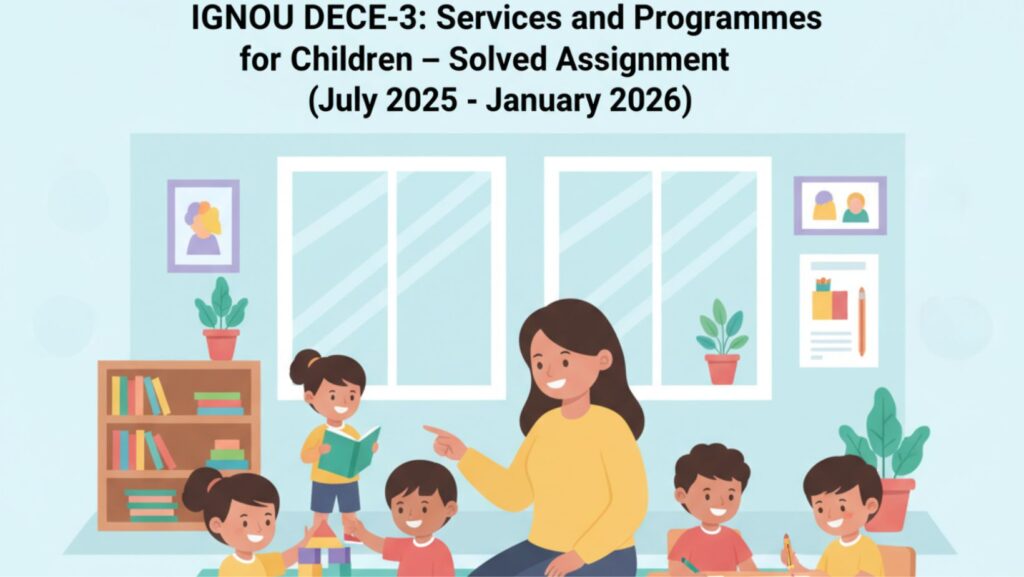IGNOU DECE-3: Services and Programmes for Children – Solved Assignment (July 2025 – January 2026)

Introduction
IGNOU’s Diploma in Early Childhood Care and Education (DECE) is a course that would prepare students with the skills and knowledge required to work with young children. One of the foundational courses, DECE-3: Services and Programmes for Children, deals with a host of services and programs designed to foster the well-being and growth of children.
This blog article is a detailed guide to the DECE-3 solved assignment for the July 2025 – January 2026 session. The assignment contains three parts:
- Section A: Theory Questions (60 Marks)
- Section B: Practical Exercises (20 Marks)
- Section C: Project Work (20 Marks)
Note that this entry is for Section A only, since Sections B and C have practical elements that need to be experienced by hand and thus cannot be delivered in solved form.
Section A: Theoretical Questions
Q1: Define, providing examples, who are children with special needs.
Answer:
Children with special needs are those who need extra support because of physical, intellectual, emotional, or development difficulties. They could develop these needs due to a range of conditions such as:
- Physical Disabilities: Medical conditions such as cerebral palsy or muscular dystrophy that hamper mobility and physical coordination.
- Cognitive Disabilities: Intellectual disabilities which hinder learning capabilities and problem-solving.
- Emotional and Behavioral Disorders: Medical conditions like ADHD, anxiety disorders, or oppositional defiant disorder that influence behavior and emotional control.
- Sensory Impairments: Hearing or visual impairments that restrict sensory input and communication.
Examples: - A child with ADHD might have difficulty concentrating in a classroom environment.
- A deaf child can be supported through the use of sign language to ensure proper communication.
Support for children with special needs includes designing an inclusive atmosphere, one-on-one attention, and multidisciplinary collaboration to help meet their special demands.
Q2: Write briefly on each of the following in 400 words:
a) Role play as a method of communication
Answer:
Role play is a participatory technique where children act out roles and perform scripts to communicate. It enhances communication skills by promoting verbal and non-verbal communication, building vocabulary, and encouraging social interaction. For example, the game of “teacher-student” enables children to practice language and become familiar with social roles.
b) Parents with an aggressive attitude
Answer:
Parents with a hostile attitude can show anger, aggression, or rejection of the child’s education or caregivers. A solution to this is establishing trust, honest communication, and showing support to the parents in realizing how positive involvement is vital in the child’s growth.
c) Tarabai Modak’s contribution to preschool education in India
Answer:
Tarabai Modak was a path-breaking educator who implemented novel approaches in preschool education in India. She stressed play-based learning and child-centered strategies, which formed the core of early childhood education practices in the nation today.
d) Elements of communication
Answer:
Effective communication entails a number of crucial elements:
- Sender: The person sending the message.
- Message: The information being sent.
- Medium: The medium by which the message is sent.
- Receiver: The receiver of the message.
- Feedback: Receiver’s feedback which shows that he or she has understood.
Knowing these aspects is important to establish effective communication in the educational environment.
Q3: Describe how the preschool teacher/caregiver can respond to and manage:
a) A child who exhibits withdrawn behavior
Answer:
A preschool teacher can assist a withdrawn child by:
- Providing a Safe Environment: Making the child feel safe and appreciated.
- Encouraging Participation: Helping the child to participate in tasks without forcing them.
- Building Trust: Establishing a solid, supportive relationship to encourage confidence-building in the child.
b) A child exhibiting fear and phobia
Answer:
Tackling a fearful child requires:
- Identifying Triggers: Knowing why the child is afraid or phobic.
- Gradual Exposure: Gradually exposing the child to the feared object or situation in a controlled setting.
- Providing Reassurance: Being reassuring and giving positive feedback to alleviate anxiety.
Section B: Practical Exercises
Note: Section B comprises practical exercises that involve real-life interaction and cannot be presented in a solved form.
Section C: Project Work
Note: Section C entails the completion of a project involving practical application and cannot be presented in a solved form.
Conclusion
The DECE-3: Services and Programmes for Children program provides insights into the diverse services and programs that facilitate children’s development. Educators can establish effective and safe learning environments by understanding and responding to the needs of children with special needs.
For more comprehensive solutions and advice, students are urged to consult the official IGNOU materials and their tutors.
